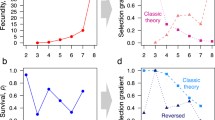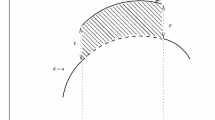Abstract
The part of Cole’s article included here outlines the relationship of Thompson’s work (1931, paper 20 above) to stable population theory. Omitted sections discuss the relationships between the rate of increase, numbers and spacing of offspring, and age structure, with their implications for species survival.
From Quarterly Review of Biology 29. Excerpts are from pages 107–115.
Access this chapter
Tax calculation will be finalised at checkout
Purchases are for personal use only
Preview
Unable to display preview. Download preview PDF.
Similar content being viewed by others
List of Literature
Archibold, R, C. 1918. A Fibonacci series. Amer. math. Monthly, 25: 235–238.
Birch, L. C. 1948. The intrinsic rate of natural increase of an insect population. J. Anim. Ecol., 17: 15–26.
Chapman, R. N. 1938. Animal Ecology. McGraw-Hill, New York.
Dublin, L. I., and A. J. Lotka. 1925. On the true rate of natural increase as exemplified by the population of the United States, 1920. J. Amer. statist. Ass., 20:305–339.
Dunkel, O. 1925. difference eSolutions of a probabilityquation. Amer. math. Monthly, 32: 354–370
Evans, F. C., and F. E. Smith. 1952. The intrinsic rate of natural increase for the human louse, Pediculus humanus L. Amer. Nat., 86: 299–310.
Fibonacci, L. (1857). Liber Abbaci di Leonardo Pisano publicati da Baldasarre Boncompagni. Tipografia delle Scienze mathematiche e fisiche, Roma.
Fisher, R. A.1930. The Genetical Theory of Natural Selection. Oxford Univ. Press, London.
Jordan, C. 1950. Calculus of Finite Differences, 2nd ed. Chelsea, New York.
Kuczynski, R. R.1932. Fertility and Reproduction. Falcon Press, New York.
Leslie, P. H., and R. M. Ranson. 1940. The mortality, fertility, and rate of natural increase of the vole (Microtus agrestis) as observed in the laboratory. J. Anim. Ecol., 9: 27–52.
—, and T. PARK. 1949. The intrinsic rate of natural increase of Tribolium castaneum Herbst. Ecology, 30: 469–477.
Linnaeus, C. 1743. Oratio de telluris habitabilis. In Amoenitates Academicae seu Dissertationes Variae Editio tertia curante J. C. D. Schre-bero, 1787, Vol. 2:430–457. J. J. Palm, Erlangae.
Lotka, A. J. 1907a. Relation between birth rates and death rates. Science, 26: 21–22.
—. 1907b. Studies on the mode of growth of material aggregates. Amer. J. Sci., 24: 119–216.
Malthus, T. R. 1798. An Essay on the Principle of Population ds it Affects the Future Improvement of Society, with Remarks on the Speculations of Mr. Godwin, M. Condorcet, and Other Writers. Printed for J. Johnson in St. Paul’s Churchyard, London.
Mendes, L. O. 1949. Determinagao do potencial biotico da “broca do cafe”—Hypothenemus hampei (Ferr.)—e consideracoes s6bre o crescimento de sua populacao. Ann. A cad. bras. Sci., 21:275–290.
Milne-thompson, L. M. 1933. The Calculus of Finite Differences. Macmillan, London.
Molisch, H. 1938. The Longevity of Plants. E. H. Fulling, Lancaster Press, Lancaster, Pa.
Pierce, J. C. 1951. The Fibonacci series. Sci. Monthly, 73:224–228.
Rhodes, E. C. 1940. Population mathematics. J. R. statist. Soc., 103: 61–89, 218–245, 362–387.
Sadler, M. T. 1830. The Law of Population: A Treatise, in Six Books; in Disproof of the Super-fecundity of Human Beings, and Developing the Real Principle of their Increase. Murray, London.
Sharpe, F. R., and A. J. Lotka. 1911. A problem in age distribution. Phil. Mag., 21: 435–438.
Thompson, D’Arcy W. 1942. On Growth and Form, new ed. Cambridge Univ. Press, Cambridge.
Thompson, W. R. 1931. On the reproduction of organisms with overlapping generations. Bull. ent. Res., 22: 147–172.
Rights and permissions
Copyright information
© 1977 Springer-Verlag Berlin · Heidelberg
About this chapter
Cite this chapter
Cole, L.C. (1977). The Population Consequences of Life History Phenomena. In: Mathematical Demography. Biomathematics, vol 6. Springer, Berlin, Heidelberg. https://doi.org/10.1007/978-3-642-81046-6_21
Download citation
DOI: https://doi.org/10.1007/978-3-642-81046-6_21
Publisher Name: Springer, Berlin, Heidelberg
Print ISBN: 978-3-642-81048-0
Online ISBN: 978-3-642-81046-6
eBook Packages: Springer Book Archive




